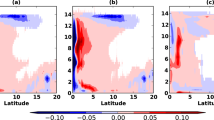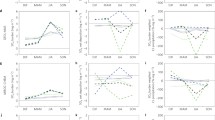Abstract
As global greenhouse warming continues to intensify, it is likely that demands to employ technologies of climate engineering will become increasingly insistent. This paper addresses the possibility of ‘canceling’ the radiative effects of the increasing greenhouse gases through solar reflectors. Two promising approaches, according to COSEPUP (1992), are the employment of aerosols in the stratosphere, directly as reflectors, or in the troposphere, for the ‘seeding’ of clouds to increase cloud amounts and brightness. Besides technological and economic feasibility, such schemes could be relatively reversible, and describing their impact may be within the reach of future scientific study.
The climate system is not yet sufficiently understood for such actions to be warranted. However, there is considerable potential for an increased understanding of what such actions might do through the study of the role of similar aerosols already added to the climate system. In particular, the most intense volcanoes (e.g. Pinatubo) supply the stratosphere with enough aerosol over a period of a year or two to cancel out greenhouse warming from a resulting doubling of carbon dioxide. Furthermore, the addition of sulfate aerosols to the troposphere from the burning of fossil fuel may already be canceling out globally up to half of the greenhouse-gas warming. These comparisons suggest that at least 10 times as much sulfate aerosol would be needed in the troposphere as would be needed in the stratosphere for a comparable climatic effect. A better understanding of the role of the already-present aerosols is a prerequisite for further progress in the use of aerosols for climate engineering. The links between the horizontal and vertical distribution of radiative sources and sinks and various atmospheric feedback processes, especially those related to the hydrological cycle and the consequent global and regional responses, are also needed.
Similar content being viewed by others
References
Andreae, M. O.: 1995, ‘Climatic Effects of Changing Atmospheric Aerosol Level’, Chapter 10, World Survey of Climatology XVI, A. Henderson-Sellers, (ed.), Future Climates of the World, Elsevier, Amsterdam, pp. 347–399.
COSEPUP: 1992, ‘Policy Implications of Greenhouse Warming, Mitigation, Adaptation, and the Science Base, Panel on Policy Implications of Greenhouse Warming, Committee on Science, Engineering, and Public Policy, National Academy of Sciences, National Academy Press, 918 pp.
Cox, S. J., Wang, W.-C., and Schwartz, S. E.: 1995, ‘Climate Response to Radiative Forcings by Sulfate Aerosols and Greenhouse Gases’, Geophys. Res. Lett. 22, 2509–2512.
Hall, D. O. and House, J. I.: 1994, ‘Trees and Biomass Energy: Carbon Storage and/or Fossil Fuel Substitution?’ Biomass and Bioenergy 6, 11–30.
Hansen, J. E., Lacis, A., Ruedy, R., and Sato, M.: 1992, ‘Potential Climate Impact of Mount Pinatubo Eruption’, Geophys. Res. Lett. 19, 215–218.
Hanson, D. R., Ravishankara, A. R., and Solomon, S.: 1994, ‘Heterogeneous Reactions in Sulfuric Acid Aerosols: A Framework for Model Calculations’, J. Geophys. Res. 99, 3615–3629.
Hegg, D. A.: 1994, ‘Cloud Condensation Nucleus-Sulfate Mass Relationship and Cloud Albedo’, J. Geophys. Res. 99, 25, 903–25, 907.
Henderson-Sellers, A.: 1986, ‘Increasing Cloud in a Warmer World’, Clim. Change 9, 267–309.
Hofman, D. J. and Solomon, S.: 1989, ‘Ozone Destruction Through Heterogeneous Chemistry Following the Eruption of El Chichon, J. Geophys. Res. 94, 5029–5041.
IPCC: 1990, in J. T. Houghton, G. J. Jenkins, and J. J. Ephraums (eds.), Climate Change: The IPCC Scientific Assessment, Cambridge University Press, Cambridge, MA.
IPCC: 1994, in J. T. Houghton, L. G. Meira Filho, J. Bruce, H. Lee, B. A. Callander, E. Haites, N. Harris, and K. Maskell (eds.), Climate Change 1994: Radiative Forcing of Climate Change and an Evaluation of the IPCC IS92 Emission Scenarios, Cambridge University Press, Cambridge, MA.
IPCC: 1995, in J. T. Houghton, B. A. Callander, and L. G. Meira Filho (eds.), Climate Change 1995: The Science of Climate Change, Cambridge University Press, Cambridge, MA.
Lacis, A., Hansen, J., and Sato, M.: 1992, ‘Climate Forcing by Stratospheric Aerosols’, Geophys. Res. Lett. 19, 1607–1610.
Martin, J. H., Coale, K. H., Johnson, K. S., Fitzwater, S. E., Gordon, R. M., Tanner, S. J., Hunter, C. N., Elrod, V. A., Nowicki, J. L., Coley, T. L., Barber, R. T., Lindley, S., Watson, A. J., Van Scoy, K., Law, C. S., Liddicoat, M. I., Ling, R., Stanton, T., Stockel, J., Collins, C., Anderson, A., Bidigare, R., Ondrusek, M., Latasa, M., Millero, F. J., Lee, K., Yao, W., Zhang, J. Z., Friederich, G., Sakamoto, C., Chavez, F., Buck, K., Kolber, Z., Greene, R., Falkowski, P., Chisholm, S. W., Hoge, F., Swift, R., Yungel, J., Turner, S., Nightingale, P., Hatton, A., Liss, P., and Tindale, N. W.: 1994, Testing the Iron Hypothesis in Ecosystems of the Equatorial Pacific Ocean, Nature 371, 123–129.
Minnis, P., Harrison, E. F., Gibson, G. G., Denn, F. M., Doelling, D. R., and Smith Jr., W. L.: 1993, ‘Radiative Forcing by the Eruption of Mt. Pinatubo Deduced from NASA's Earth Radiation Budget Experiment Data’, Science 259, 1411–1415.
Monastersky, R.: 1995, ‘Iron Versus the Greenhouse’, Science News 148, 220–222.
Mudur, G.: 1995, ‘Monsoon Shrinks with Aerosol Models’, Science 270, 1922.
Penner, J. E., Charlson, R. J., Hales, J. M., Laulainen, N. S., Leifer, R., Novakov, T., Ogren, J., Radke, L. F., Schwartz, S. E., and Travis, L.: 1994, ‘Quantifying and Minimizing Uncertainty of Climate Forcing by Anthropogenic Aerosols’, BAMS 75, 375–400.
Pilinis, C., Pandis, S., and Seinfeld, J. H.: 1995, ‘Sensitivity of Direct Climate Forcing by Atmospheric Aerosols to Aerosol Size and Composition’, J. Geophys. Res. 100, 18, 739–18, 754.
Pintos, J. P., Turco, R. P., and Toon, O. B.: 1989, ‘Self-Limiting Physical and Chemical Effects in Volcanic Eruption Clouds’, J. Geophys. Res. 94, 11, 165–11, 174.
Prather, M.: 1992, ‘Catastrophic Loss of Stratospheric Ozone in Dense Volcanic Clouds’, J. Geophys. Res. 97, 10187–10191.
Stouffer, R. J., Manabe, S., and Vinnikov, K. Ya.: 1994, ‘Model Assessment of the Role of Natural Variability, I. Recent Global Warming’, Nature 367, 634–636.
Taubman, S. J. and Kasting, J. F.: 1995, ‘Carbonyl Sulfide: No Remedy for Global Warming’, Geophys. Res. Lett. 22, 803–805.
Taylor, K. E. and Penner, J. E.: 1994, ‘Response of the Climate System to Atmospheric Aerosols and Greenhouse Gases’, Nature 369, 734–737.
Zhao, J., Turco, R. P., and Toon, O. B.: 1995, ‘A Model Simulation of Pinatubo Aerosols in the Stratosphere’, J. Geophys. Res. 100, 7315–7328.
Author information
Authors and Affiliations
Rights and permissions
About this article
Cite this article
Dickinson, R.E. Climate engineering a review of aerosol approaches to changing the global energy balance. Climatic Change 33, 279–290 (1996). https://doi.org/10.1007/BF00142576
Received:
Revised:
Issue Date:
DOI: https://doi.org/10.1007/BF00142576




